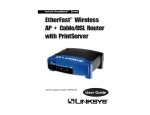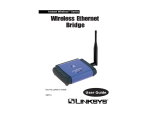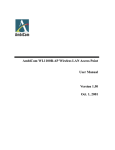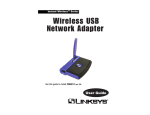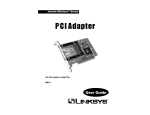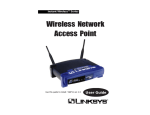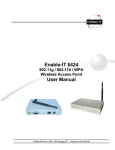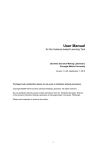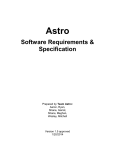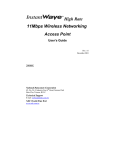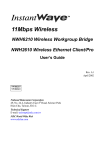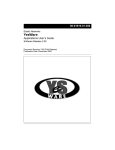Download Atmel Wireless LAN Access Point User guide
Transcript
Instant WirelessTM Series Wireless Network Access Point Use this guide to install: WAP11 User Guide COPYRIGHT & TRADEMARKS Copyright © 2001 Linksys, All Rights Reserved. Instant Wireless™ is a registered trademark of Linksys. Microsoft, Windows, and the Windows logo are registered trademarks of Microsoft Corporation. All other trademarks and brand names are the property of their respective proprietors. LIMITED WARRANTY Linksys guarantees that every Wireless Network Access Point is free from physical defects in material and workmanship under normal use for one year from the date of purchase. If the product proves defective during this warranty period, call Linksys Customer Support in order to obtain a Return Authorization Number. BE SURE TO HAVE YOUR PROOF OF PURCHASE AND A BARCODE FROM THE PRODUCT'S PACKAGING ON HAND WHEN CALLING. RETURN REQUESTS CANNOT BE PROCESSED WITHOUT PROOF OF PURCHASE. When returning a product, mark the Return Authorization Number clearly on the outside of the package and include your original proof of purchase. All customers located outside of the United States of America and Canada shall be held responsible for shipping and handling charges. IN NO EVENT SHALL LINKSYS’ LIABILITY EXCEED THE PRICE PAID FOR THE PRODUCT FROM DIRECT, INDIRECT, SPECIAL, INCIDENTAL, OR CONSEQUENTIAL DAMAGES RESULTING FROM THE USE OF THE PRODUCT, ITS ACCOMPANYING SOFTWARE, OR ITS DOCUMENTATION. LINKSYS DOES NOT OFFER REFUNDS FOR ANY PRODUCT. Linksys makes no warranty or representation, expressed, implied, or statutory, with respect to its products or the contents or use of this documentation and all accompanying software, and specifically disclaims its quality, performance, merchantability, or fitness for any particular purpose. Linksys reserves the right to revise or update its products, software, or documentation without obligation to notify any individual or entity. Please direct all inquiries to: Linksys P.O. Box 18558, Irvine, CA 92623. FCC STATEMENT This product has been tested and complies with the specifications for a Class B digital device, pursuant to Part 15 of the FCC Rules. These limits are designed to provide reasonable protection against harmful interference in a residential installation. This equipment generates, uses, and can radiate radio frequency energy and, if not installed and used according to the instructions, may cause harmful interference to radio communications. However, there is no guarantee that interference will not occur in a particular installation. If this equipment does cause harmful interference to radio or television reception, which is found by turning the equipment off and on, the user is encouraged to try to correct the interference by one or more of the following measures: • • • • Reorient or relocate the receiving antenna Increase the separation between the equipment or device Connect the equipment to an outlet other than the receiver’s Consult a dealer or an experienced radio/TV technician for assistance FCC Radiation Exposure Statement This equipment complies with FCC radiation exposure limits set forth for an uncontrolled environment. This equipment should be installed and operated with minimum distance 20cm between the radiator and your body. UG-WAP11-10719D DG Instant WirelessTM Series Table of Contents Wireless Network Access Point Introduction Introduction The Instant WirelessTM Wireless Network Access Point Features Package Contents System Requirements 1 1 1 2 2 Planning Your Wireless Network Network Topology Roaming 3 3 3 Getting to Know the Wireless Network Access Point The Wireless Access Point’s Rear Panel The Wireless Access Point’s Front Panel 4 4 6 Connecting and Setting Up the Wireless Network Access Point 7 Installing the USB Drivers for the Wireless Network Access Point Installing the Driver Software for Windows 98 Installing the Driver Software for Windows Millennium Installing the Driver Software for Windows 2000 8 8 10 11 Configuring the Wireless Network Access Point Installing the Configuration Utility 14 14 The USB Configuration Utility Configuring the Wireless Network Access Point with the USB Configuration Utility 18 18 The Access Point’s SNMP Configuration Utility Creating a Temporary IP Address Configuring the Wireless Network Access Point with the Access Point’s SNMP Configuration Utility 28 28 29 Troubleshooting Common Problems and Solutions Frequently Asked Questions 40 40 40 Glossary 44 Specifications Environmental 49 50 Warranty Information 51 Contact Information 52 The Instant WirelessTM Wireless Network Access Point Don’t be bound by cabling restrictions any longer! The Instant Wireless™ Network Access Point from Linksys delivers the freedom to configure your network your way. Utilization of state-of-the-art wireless technology gives you the ability to set up workstations in ways you never though possible; no cables to install means fewer expenses and fewer hassles. The Instant Wireless™ Network Access Point’s high-powered antennas offer a range of operation of up to 457 meters, providing seamless roaming throughout your LAN infrastructure. Advanced user authentication ensures a high level of security for wireless networking, while easy-to-use Windows-based diagnostics and statistic tools ensure that you’ll always be in control. Best of all, the Instant Wireless Network Access Point features easy installation— just plug it in and you’re ready to go! When all these features come together in one compact, lightweight, and powerefficient unit, you have the ultimate in flexible networking—the Linksys Instant Wireless™ Network Access Point. Features • Highly Efficient Dipole Antennas Provide Extensive Range of Operation • Enjoy Your Wireless Office Beyond the Range of Ethernet Networking • Auto Fall-Back Data Rate for Long-Distance Communication and Noisy Environments • High-Speed Data Transfer Rate Up to 11 Mbps • Interoperable with IEEE 802.11b (DSSS) 2.4GHz-Compliant Equipment • Features Roaming, Best Access Point Selection, Load Balancing, and Network Traffic Filtering • Extensive Operating Range Supports 150m (Indoors) and 500m (Outdoors) • 64-Bit Wired Equivalent Privacy • Free Software Driver Upgrades • Compatible with Virtually All Major Operating Systems • Auto Fallback Data Rate for Long-Distance Communication and Noisy Environments • Free Technical Support—24 Hours a Day, 7 Days a Week for North America Only • 1-Year Limited Warranty 1 Instant WirelessTM Series Wireless Network Access Point Planning Your Wireless Network Network Topology A wireless LAN is a group of computers, each equipped with one Instant Wireless™ Network Card. Computers in a wireless LAN must be configured to share the same radio channel. The Instant Wireless™ Network Card provides access to a wired LAN for wireless workstations. An integrated wireless and wired LAN is called an Infrastructure configuration. A group of Instant Wireless™ Network Card users and an Instant Wireless™ Network Access Point compose a Basic Service Set (BSS). Each Instant Wireless™ Network Card PC in a BSS can talk to any computer in a wired LAN infrastructure via the Instant Wireless™ Network Access Point. Package Contents • • • • • • One Instant WirelessTM Network Access Point One AC Power Adapter One Setup CD-ROM One User Guide and Registration Card Two Detachable Antennas One USB Cable System Requirements • A PC with USB Support or Ethernet Connection • Windows 95, 98, Millennium, NT version 4.0, or 2000 Professional • 500 Kbytes of free disk space for utility and driver installation • A 10 Mbps Category 3 or Better network RJ-45 connection Linux/Unix Users: Though these operating systems are not supported by Linksys, the Wireless Access Point should work in these environments. The WAP11 can be configured under these operating systems using SNMP. A configurable Management Information Base file (MIB) named AT76C510.MIB can be found on the Setup Utility CD. This file is for Linux/Unix users only, and is not necessary for any Windows installation. 2 An infrastructure configuration extends the accessibility of an Instant Wireless™ Network Card PC to a wired LAN, and doubles the effective wireless transmission range for two Instant Wireless™ Network Card PCs. Since the Wireless Network Access Point is able to forward data within its BSS, the effective transmission range in an infrastructure LAN is doubled. The use of a unique ID in a BSS is essential. All Instant Wireless™ Network PC Card PCs configured without roaming options in an independent BSS must be configured with a BSS ID used in the BSS. The wireless LAN Infrastructure configuration is appropriate for enterprisescale wireless access to a central database, or as a wireless application for mobile users. Roaming Infrastructure mode also supports roaming capabilities for mobile users. More than one BSS can be configured as an Extended Service Set (ESS). This continuous network allows users to roam freely within an ESS. All Instant Wireless™ Network PC Card PCs within one ESS must be configured with the same ESS ID and use the same radio channel. Before enabling an ESS with roaming capability, choosing a feasible radio channel and optimum Wireless Network Access Point position is recommended. Proper Wireless Network Access Point positioning combined with a clear radio signal will greatly enhance performance. 3 Instant WirelessTM Series Getting to Know the Wireless Network Access Point The Wireless Access Point’s Rear Panel The ADSL Modem Router’s Rear Panel Your Access Point’s ports, where network cables are connected, are located on the rear panel of your Access Point. Wireless Network Access Point Your Access Point comes with a USB cable that has two different types of connectors. Type A, the master connector, is shaped like a rectangle and plugs into your PC’s USB Compatibility with Your PC To use the USB port on the Wireless Network Access Point, you must have Windows 98, 2000, or Millennium installed on your PC. USB is not supported in a Windows 95 or NT environment. Also, your PC must have a USB port installed and enabled. Some PCs may have a disabled USB port. If your port doesn’t seem to be working, there may be jumpers on the motherboard or a menu option in the BIOS to enable a PC’s USB port. Other motherboards have USB interfaces, but no ports. You can install your own USB port and attach it to your PC’s motherboard using hardware purchased at retail computer stores. See your PC’s User Guide for instructions. The Wireless Network Access Point’s Ports Dipole Antenna Connectors These two round connections are where the antennas are connected to the Access Point. LAN This LAN (Local Area Network) port connects to network devices, such as a hub, switch, or router. Power The Power port is where you will connect the power adapter. Be sure to connect the power cord to the power adapter before plugging it in. Configuration Port The Configuration Port is a USB port (Type Bslave) which connects to a USB-ready PC in order to configure the Access Point’s settings. To work with USB ports, your PC must be running Windows 98, 2000, or Millennium. Note: The Configuration Port does not connect your Access Point to your PC (or any other device) for networking purposes. Its only function is to allow you to configure your Access Point’s settings. Once the Access Point is configured, you may remove the USB cable connecting the Access Point to your PC. 4 USB port. Type B, the slave connector, resembles a square and connects to the USB port on the rear panel of your Wireless Network Access Point. USB Type A USB Type B There is no USB Support on PCs running Windows 95 or Windows NT. 5 Instant WirelessTM Series T The Wireless Access Point’s Front Panel he ADSL Modem + Router’s LEDs Wireless Network Access Point Connecting and Setting Up the Wireless Network Access Point 1. Locate an optimum location for the Wireless Network Access Point. The best place for your Wireless Network Access Point is usually at the center of your wireless network, with line of sight to all of your mobile stations. The LAN Indicators Power Link Act Red. The Power LED lights up when the Access Point is powered on. Amber. The Link LED serves two purposes. If the LED is continuously lit up, the Access Point is successfully connected to a device through the LAN port. If the LED is flickering, it is an indication of any network activity. Green. The Act LED is lit to show that other wireless devices are accessing the Access Point. If the LED is flickering, the Access Point is actively sending or receiving data to or from one of the wireless devices on the network. 2. Fix the direction of the antenna. Try to place it in a position which can best cover your wireless network. Normally, the higher you place the antenna, the better the performance will be. The antenna’s position enhances the receiving sensitivity. 3. Connect an RJ-45 connector to the Wireless Network Access Point. Then, connect the other end of the Ethernet cable to a switch or hub. The Wireless Network Access Point will then be connected to your 10/100 Network. 4. Connect the AC Power Adapter to the Wireless Network Access Point’s Power Socket. Only use the power adapter supplied with the Wireless Network Access Point. Use of a different adapter may result in product damage. 5. Connect the appropriate end of the USB Cable to the Wireless Network Access Point’s Configuration Port. Connect the other end to the USB port on your PC. If your USB port is working properly, your system should immediately recognize the Access Point and attempt to install drivers for it. Continue on to the next section for instructions on how to install the drivers. Now that the hardware installation is complete, proceed to Installing the USB Drivers for the Wireless Network Access Point and The USB Configuration Utility for configuring the Access Point through your PC’s USB port. To configure the Access Point through an Ethernet or Wireless connection, proceed to The Access Point’s SNMP Configuration Utility. The Hardware Installation is complete. Note: Once your Access Point is installed and configured, the USB cable may be removed. 6 7 Instant WirelessTM Series Installing the USB Drivers for the Wireless Network Access Point Wireless Network Access Point 3. Windows will now ask you where to search for the driver software. Select Specify a location and type in the blank field D:\WAP11\WIN9X (where “D” specifies your CD-ROM). Then, click the Next button. Installing the Driver Software for Windows 98 1. Windows 98 will automatically identify the Wireless Network Access Point, once it is connected to the PC, and prompt you to install the necessary driver. Make sure that the Setup Utility CD is inserted into your CD-ROM drive and click the Next button on the Add New Hardware Wizard screen to proceed. (When you insert the Setup Utility CD, the installation may try to run automatically. If it does, exit out of the program and return here.) 4. Windows will now search for the driver. After Windows has acknowledged finding the driver, click the Next button. 2. Select Search for the best driver... and click the Next button. This will search for the Windows 98 driver. 5. Windows will now install the driver files. Click the Finish button when completed. 6. Continue on to the Configuring the Wireless Network Access Point section for software installation. 8 9 Instant WirelessTM Series Wireless Network Access Point Installing the Driver Software for Windows Millennium Installing the Driver Software for Windows 2000 1. Windows Millennium will automatically identify the Wireless Network Access Point, once it is connected to the PC, and prompt you to install the necessary driver. 1. Windows 2000 will automatically identify the Wireless Network Access Point, once it is connected to the PC, and prompt you to install the necessary driver. Make sure that the Setup Utility CD is inserted into your CD-ROM drive and click the Next button on the Found New Hardware Wizard screen to proceed. 2. Select Automatic Search for a better driver (Recommended) and click the Next button. This will search for the Windows Millennium driver. 3. Windows will now install the driver files. Click the Finish button when completed. Windows may ask for the driver, which is located at “D:\WAP11\USBDrv” (where “D” specifies your CD-ROM drive). Click OK. 2. Select Search for a suitable driver... and click the Next button. This will search for the Windows 2000 driver. 4. Continue on to the Configuring the Wireless Network Access Point section for software installation now. 10 11 Instant WirelessTM Series 12 Wireless Network Access Point 3. Under “Optional Search Locations”, select Specify a location and click the Next button. 5. Windows will now install the driver files. Click the Finish button when completed. 4. You will be prompted to enter a path; type “D:\WAP11\usbdrv” (where D: is the letter of your CD-ROM drive) and click OK. Windows will now search for the driver. After Windows has acknowledged finding the driver, click the Next button. 6. Continue on to the Configuring the Wireless Network Access Point section for software installation. 13 Instant WirelessTM Series Configuring the Wireless Network Access Point Wireless Network Access Point 1. The following screen should appear. The Wireless Network Access Point can be configured one of two ways, through the USB Utility or the Access Point SNMP Configuration Utility. USB Utility The USB Utility can be used when configuring the Wireless Network Access Point through a USB connection and is compatible with Windows 98, Millennium, and 2000. Access Point SNMP Configuration Utility The Access Point SNMP Configuration Utility can be used when configuring the Wireless Network Access Point through an Ethernet connection and is compatible with all Windows Operating Systems. You may also configure the Access Point through its wireless connections. Click on the WAP11 product button in the column on the left to select it. Note: In order for all other wireless devices to communicate with the Wireless Network Access Point, those devices must be operating in the Infrastructure Mode. If any wireless devices are configured in the Ad Hoc Mode, they will not be recognized by the Access Point. 2. When this screen appears, click on the Install tab to start the setup. Linux/Unix Users: Since the Configuration Utility is written for Windows users, you will have to configure the Wireless Access Point using SNMP. A configurable MIB file (AT76C510.MIB) can be found on the Setup Utility CD. Remember, Linksys does not support Linux or Unix as an operating system. This file is for Linux/Unix users only, and is not necessary for any Windows installation. Installing the Configuration Utility Insert the Setup Utility CD into your CD-ROM Drive. The Setup Utility should run automatically and the screen shown on the top of the next page should appear. If it does not, click the Start button and choose Run. In the box that appears, enter D:\setup.exe (where “D” is the letter of your CD-ROM drive). 14 Note: This useful menu screen can be accessed at any time, simply by inserting the Setup Utility CD into your CD-ROM drive. From this menu, software can be uninstalled, you may view online documentation and contact information. 15 Instant WirelessTM Series 3. When the Welcome screen appears, click Next to continue. Wireless Network Access Point 5. The Choose Destination Location screen will show you the default destination chosen by the utility. It is recommended that you leave the default destination, but if you want to install this in another location, click the Browse button and select an alternate destination. When you are ready to continue, click the Next button. 4. Read the terms of the License Agreement, and if you agree, click Yes; otherwise, click No to cancel the configuration process. 6. The Configuration Utility has now been installed. Select Yes to restart your PC and then click Finish. 16 17 Instant WirelessTM Series Wireless Network Access Point The USB Configuration Utility The USB Configuration Utility is provided to allow you further customization of the Wireless Network Access Point and your wireless network through your USB port. Configuring the Wireless Network Access Point with the USB Configuration Utility THE STATUS TAB The Status tab will display the Wireless Network Access Point’s current status. From this tab, you can view the status information along with reconnecting to the Wireless Network Access Point and restoring its default settings. • • • • • • Working Status. This will display your current connection status, notifying you of any problems with the connection. Regulation Domain. This status shows that the Access Point is operating under FCC guidelines. Firmware Version. This will display the present version of the Access Point’s firmware. Ethernet Address. This will display the MAC Address of your current Ethernet connection. ESSID. The unique name shared among all points in your wireless network will be displayed here. Channel. The wireless channel shared by all of the points in your wireless network will be displayed here. • • • WEP. If you have not enabled WEP encryption, this will read Disabled. It will read Enabled when WEP encryption is in use. Reconnect. If, for any reason, the USB connection to the Wireless Network Access Point is disconnected, you can reconnect the USB cable and click the Reconnect button here. This will retrieve all of the data from the Wireless Network Access Point so you will be ready to use the USB Configuration Utility again. Restore Defaults. Click this button to restore the Wireless Network Access Point’s default settings. Any setting you may have made through the USB Utility will be lost if this button is clicked. Click the Apply button to store the information, then click the Yes button to accept the changes in the dialog box that appears. If you have not already clicked the Apply button, the Close button will close the USB Utility without saving any changes. Clicking the Cancel button will cancel any changes. 18 19 Instant WirelessTM Series THE BASIC SETTING TAB The Wireless Network Access Point will automatically detect the settings to your wireless network. Changing these values will alter your current wireless network configuration. • • • 20 ESSID. The ESSID or SSID is the unique name shared among all points in a wireless network. The ESSID must be identical for all points in the wireless network. It is case sensitive and must not exceed 32 characters. Make sure that all points in the wireless network are the same. Verify that you’re using the correct ESSID and click the Apply button to set it. Channel. Select the appropriate channel from the list provided to correspond with your network settings, between 1 and 11 (in North America). All points in your wireless network must use the same channel in order to function correctly. Verify that the correct channel is selected and click the Apply button to set it, then click the Yes button to accept the changes in the dialog box that appears. Wireless Network Access Point THE ADVANCED TAB Before making any changes to the Advanced tab, please check your wireless settings on other systems, as these changes will alter the effectiveness of the Wireless Network Access Point. In most cases, these settings do not need to be changed. • Fragmentation Threshold. If you experience a high packet error rate, try to slightly increase your Fragmentation Threshold. The value should remain at its default setting of 2,346. Setting the Fragmentation Threshold too low may result in poor performance. • RTS Threshold. This value should remain at its default setting of 2,346. Should you encounter inconsistent data flow, only minor modifications are recommended. Access Point Name. You may assign any name to your Access Point. Unique, memorable names are helpful, especially if you are employing multiple Access Points on the same network. 21 Instant WirelessTM Series • Authentication Type. You may choose between Open System, Shared Key, and Both. The Authentication Type default is set to Open System, in which the sender and the recipient do NOT share a secret key. Each party generates its own key-pair and asks the receiver to accept the randomlygenerated key. Once accepted, this key is used for a short time only. Then a new key is generated and agreed upon. Even if this secret key is discovered, only a small amount of data may be deciphered. Shared Key is when both the sender and the recipient share a secret key. They use this key for an extended length of time, sometimes indefinitely. Any eavesdropper who discovers the key may decipher all packets until the key is changed. • Preamble Type. The preamble defines the length of the CRC block for communication between the Wireless Network Access Point and the roaming Network Card. Verify that you have selected the apropriate preamble type and click the Apply button to set it. • Basic Rates. The basic transfer rates should be set depending on the speed of your wireless network. Verify that you’ve set the correct basic rate for your wireless network and click the Apply button to set it. • Antenna Diversity. These two settings determine whether either or both antennas will be used to transmit or receive. The default setting, Both, means that the antennas are set to both Transmit and Receive, which is the recommended setting. • Auto Rate Fall Back setting should be checked to make your wireless network flexible to roaming wireless devices. As wireless devices move away from the Wireless Network Access Point, the transfer rate will automatically fall back to the most optimum rate allowed. Wireless Network Access Point • Operational Mode by default is set to Access Point. This is for connecting your wireless PCs to a wired network. In most cases, no change is necessary to this default setting. If you are trying to make a wireless connection between two wired networks, select Wireless Bridge. If you are connecting to another Wireless Bridge, select Point to Point and enter in the apropriate Remote MAC Address (this address must be identical to the other Access Point’s MAC address). Note: In Wireless Bridge mode, the WAP11 can ONLY be accessed by another wireless bridge. In order for your other wireless devices to access the WAP11, you must reset it to Access Point mode. The two modes are mutually exclusive. If you plan on connecting to multiple client Access Points, you must select Point to MultiPoint. Click OK after you have made your selection. Click the Apply button to store the information, then click the Yes button to accept the changes in the dialog box that appears. 22 23 Instant WirelessTM Series THE IP SETTING TAB Wireless Network Access Point THE SECURITY TAB The IP settings for the Wireless Network Access Point are made from this tab. • IP Address. The IP address assigned here must be unique to your network. We suggest that you use the default IP address of 192.168.1.250. As this is a private IP address, you do not need to purchase an additional IP address from your service provider. Verify that it is set to the correct IP address and click the Apply button to save the changes. • IP Mask. Your mask must be set to the same Subnet Mask for the Wireless Network Access Point as your Ethernet Network. Verify that this is set to the correct Subnet Mask and click the Apply button to set it. • IP Mask. Check the box next to DHCP Enable to allow it to obtain a dynamic IP address from a DHCP server. You may also choose how the Wireless Network Access Point is to dynamically obtain an IP address— either via Wireless or Ethernet. Note: Configuring the IP address here allows you to use the SNMP Configuration Utility software. It is not necessary to make any changes to the IP address if you are not planning on using the SNMP Configuration Utility. Click the Apply button to store the information, then click the Yes button to accept the changes in the dialog box that appears. 24 WEP (Wired Equivalent Privacy) is a data privacy mechanism based on a 40 bit shared key algorithm, as described in the IEEE 802.11b standard. In order to utilize WEP encryption, all points in your wireless network must have WEP enabled and be set to the same Key Setting. For easier configuration, it is strongly recommended that you use the Passphrase feature. • WEP (Disable/64-bit WEP/128-bit WEP). In order to utilize WEP encryption, select the WEP setting from the pull-down menu. If you do not wish do utilize WEP encryption, make sure Disable is selected. • Passphrase. This is the code used when a point on the wireless network wishes to log on to the network. It is a text string with a maximum of 32 alphanumeric characters. The WEP Key Settings are based upon the Passphrase determined by you. Please type that here. Note: For security, it is recommended that you make up your own passphrase (i.e. “Home”). You must use the same passphrase or WEP key settings for all wireless computers in order for the wireless network to function properly. 25 Instant WirelessTM Series • WEP Key Setting. This setting will be the configuration key used in accessing the wireless network via WEP encryption. To generate an encryption key: Wireless Network Access Point THE INFO TAB 1. Type exactly the same case sensitive Passphrase in the PassPhrase field. For security purposes, please create your own Passphrase. 2. Click the Done button to create the encryption keys. The Passphrase generates four unique keys. 3. Make sure that the Default Key is the same for each point on the wireless network. 4. Click the Apply button to store the information. 5. Click the Yes button to accept the changes in the dialog box that appears. • Password Setting. This option allows you to choose between Read/Write and Read Only. For both options, you will be asked to type in a password and confirm it. The Info tab displays general information about Linksys and the USB Utility. The USB’s copyright date and version number are listed as well as the Utility’s firmware version. At the bottom of the screen, you will find a button that will access Linksys’ web page (once your internet connection is properly set up), the email address for technical support, and the phone number to call for technical support. • 26 Authorization Table Enable. This setting can be enabled here, but any setting changes must be made through the SNMP Utility. It is recommended that this setting be enabled using the SNMP Utility. Note: Once your Access Point is installed and configured, the USB cable may be removed. 27 Instant WirelessTM Series The Access Point’s SNMP Configuration Utility The Access Point SNMP Configuration Utility is provided to allow you further customization of the Wireless Network Access Point and your wireless network through your Ethernet or wireless connection. It is strongly recommended that you use your wireless connection to use the SNMP Configuration Utility. Linux/Unix Users: Though these operating systems are not supported by Linksys, the Wireless Access Point should work in these environments. The WAP11 can be configured under these operating systems using SNMP. A configurable Management Information Base file (MIB) named AT76C510.MIB can be found on the Setup Utility CD. This file is for Linux/Unix users only, and is not necessary for any Windows installation. Creating a Temporary IP Address If you wish to use the SNMP Configuration Utility to configure the Access Point, you must assign a temporary IP address to your computer. You may need to assign the PC a temporary IP address to gain access to the Access Point. 1. This can be done at Start, Settings, Control Panel, then Network. 2. Click on the network adapter associated with the TCP/IP and click Properties. 3. Note your current settings in order to restore your TCP/IP configuration. 4. Select Specify an IP address and enter the following values: IP - 192.168.1.50, Subnet Mask- 255.255.255.0 5. Click OK and click OK again in the Network window. 6. Restart the computer when asked. Wireless Network Access Point To restore your temporary IP address configuration, follow the steps below: 1. Follow steps 1 and 2 in the instructions above. 2. Select either Specify an IP address or Obtain IP address automatically and enter in the original values you noted earlier. 3. Click OK and click OK again in the Network window. 4. Restart your computer. Configuring the Wireless Network Access Point with the Access Point’s SNMP Configuration Utility If you wish to run the SNMP Configuration Utility, click on Start, Programs, WAP11 Configuration Utility, and WAP11 SNMP. When you first start the Access Point SNMP Configuration Utility, a screen will appear asking you to enter the Wireless Network Access Point’s IP Address. Enter the IP Address—192.168.1.250 is the default setting—and Password—public is the default password—and then click the OK button to continue. (As this is a private IP address, you do not need to purchase an additional IP Address from your service provider.) DEFAULT SETTINGS: The default IP Address is: 192.168.1.250 The default SubNet Mask is: 255.255.255.0 Make sure that you enter an IP address for the Access Point in order to access it at a later time. Once you have completed the IP Address Configuration, you can set the PC back to its previous settings. For example, to “Obtain an IP Address automatically.” 28 29 Instant WirelessTM Series Wireless Network Access Point THE STATUS TAB • Channel. The wireless channel shared by all wireless devices connected to this Access Point. The Status tab will display the Wireless Network Access Point’s current status. From this tab, you can view the status information along with reconnecting to the Wireless Network Access Point and restoring its default settings. • WEP. If you have not enabled the WEP encryption protocol, this will read Disabled. It will read Enabled when the WEP encryption protocol is in use. • Reset. If you are experiencing problems with your wireless connection, click the Reset button to reset the system. • Find AP. If you have changed the default settings of your Access Point and do not have the information at hand, pressing this button will locate all Access Points on your wired network and display their IP addresses and common name. • Reconnect. If, for any reason, the Ethernet connection to the Wireless Network Access Point is disconnected, you can reconnect the Ethernet cable and click the Reconnect button here. This will retrieve all of the data from the Wireless Network Access Point so you will be ready to use the Access Point SNMP Configuration Utility again. • Restore Defaults. Click this button to restore the Wireless Network Access Point’s default settings. Any setting you may have made through the Access Point SNMP Configuration Utility will be lost if this button is clicked. The Close button will close the SNMP Configuration Utility without saving any changes. 30 • Working Status. This will display your current connection status, notifying you of any problems with the connection. • Regulation Domain. This status shows that the Access Point is operating under FCC guidelines. • Firmware Version. This will display the present version of the Access Point’s firmware as well as the Access Point’s assigned name. • Ethernet Address. This will display the MAC Address of your Wireless Access Point. • ESSID. The unique name shared among all points in your wireless network will be displayed here. Click the Apply button to store the information, then click the Yes button to accept the changes in the dialog box that appears. 31 Instant WirelessTM Series Wireless Network Access Point THE BASIC SETTING TAB THE ADVANCED TAB The Wireless Network Access Point will automatically detect the settings to your wireless network. Changing these values will alter your current wireless network configuration. Before making any changes to the Advanced tab, please check your wireless settings as these changes will alter the effectiveness of the Wireless Network Access Point. In most cases, these settings do not need to be changed. • ESSID. The ESSID or SSID is the unique name shared among all points in a wireless network. The ESSID must be identical for all points in the network. It is case sensitive and must not exceed 30 characters. Make sure that all points in the network are set the same. Verify that you’re using the correct ESSID before clicking the Apply button. • Fragmentation Threshold Value. This value indicates how much of the Access Point’s resources are devoted to recovering packet errors. The value should remain at its default setting of 2,346. If you have decreased this value and experience high packet error rates, you can increase it again, but it will likely decrease overall network performance. Only minor modifications of this value are recommended. • Channel. Select the appropriate channel from the list provided to correspond with your network settings, between 1 and 11 (in North America). All devices that communicate with this Access Point must use the same channel in order to work correctly. Verify that the correct channel is selected before clicking the Apply button. • RTS Threshold Value. This value should remain at its default setting of 2,346. Should you encounter inconsistent data flow, only minor modifications are recommended. • Authentication Type. The authentication type defines configuration options for the sharing of wireless networks to verify identity and access privileges of roaming wireless network cards. Verify that you’ve set this to the correct authentication type before clicking the Apply button. • Preamble Type. The preamble defines the length of the CRC block for communication between the Wireless Network Access Point and the roaming wireless network card. Verify that you’ve selected the appropriate preamble type before clicking the Apply button. The Close button will close the SNMP Configuration Utility without saving any changes. Click the Apply button to store the information, then click the Yes button to accept the changes in the dialog box that appears. 32 33 Instant WirelessTM Series • • • 34 Wireless Network Access Point Basic Rates. The basic transfer rates should be set depending on the speed of your wireless network. Older, slower wireless networks should be set at 1-2 (Mbps) while a faster wireless network should be set at 1-2-5.5-11 (Mbps). Verify that you’ve set the correct basic rate for your wireless network before clicking the Apply button. If you plan on connecting to multiple client Access Points, you must select Point to MultiPoint. Click OK after you have made your selection. The Auto Rate Fall Back setting should be checked to make your wireless network flexible to roaming wireless devices. As wireless devices move away from the Wireless Network Access Point, the transfer rate will automatically fall back to the most optimum rate allowed. Click the Apply button to store the information, then click the Yes button to accept the changes in the dialog box that appears. The Close button will close the SNMP Configuration Utility without saving any changes. THE IP SETTING TAB Operational Mode by default is set to Access Point. This is for connecting your wireless PCs to a wired network. In most cases, no change is necessary to this default setting. If you are trying to make a wireless connection between two wired networks, select Wireless Bridge. If you are connecting to another Access Point, select Point to Point and enter in the apropriate Remote MAC Address (this address must be identical to the other Access Point’s MAC address). Note: In Wireless Bridge mode, the WAP11 can ONLY be accessed by another wireless bridge. In order for your other wireless devices to access the WAP11, you must reset it to Access Point mode. The two modes are mutually exclusive. The IP settings for the Wireless Network Access Point are made from this tab. This is for SNMP Configuration Utility use only. • IP Address. The IP address assigned here must be unique to your network. We suggest that you use the default IP address of 192.168.1.250. As this is a private IP address, you do not need to purchase an additional IP address from your service provider. Verify that it is set to the correct IP address and click the Apply button to save the changes. • IP Mask. Your Subnet Mask must be the same as your Ethernet Network. Verify that this is set to the correct Subnet Mask or click the Apply button to set it, and then Yes to accept the changes. The DHCP settings are also made from this tab. Check the box next to DHCP Enable to allow it to obtain a dynamic IP address from a DHCP server. You may also choose how the Wireless Network Access Point is to dynamically obtain an IP address—either via Wireless or Ethernet. No DHCP changes will take effect until the Access Point has been powered down and powered up again. 35 Instant WirelessTM Series THE SECURITY TAB Wireless Network Access Point • WEP Key Setting. This setting will be the configuration key used in accessing the wireless network via WEP encryption. To generate an encryption key: 1. Type exactly the same case sensitive PassPhrase in the PassPhrase field. 2. Click the Done button to create the encryption keys. The Passphrase generates four unique keys. 3. Make sure that the Default Key is the same for each point on the wireless network. Note: Creating and using the passphrase is recommended for easy WEP configuration and security purposes. • WEP (Wired Equivalent Privacy) is a data privacy mechanism based on a 64/128-bit shared key algorithm, as described in the IEEE 802.11 standard. In order to utilize WEP encryption, all points in your wireless network must have WEP enabled and be set to the same Key Setting. 36 • WEP (Disable/64-bit/128-bit). In order to utilize WEP encryption, select Enable from this pull-down menu. If you do not wish to utilize WEP encryption, make sure Disable is selected. When enabled, both 40-bit and 64bit WEP is compatible. • Passphrase. This is the code used when a point on the wireless network wishes to log on to the network. It is a text string with a maximum of 32 alphanumeric characters. Note: Whenever changes are made to your WEP settings, you will lose access to your network until the WEP settings are updated on the PCs. Remember that you will need to reconfigure your wireless PCs to the new WEP settings. If you are configuring this wirelessly, you will lose your connection. Authorized MAC Address. You may authorize who can gain network access through the Access Point by using MAC Address filtering. Only MAC addresses in the Authorization table will be allowed to communicate with the WAP11. To view the Authorization table of currently authorized MAC addresses click on the Get Flash button. 37 Instant WirelessTM Series To enable MAC Address Filtering follow these steps: Wireless Network Access Point THE INFO TAB 1. Create a text file (e.g. MAC.TXT) using Notepad or another text editor. 2. Enter the 10 digit MAC address of each adapter that you wish to authorize communication with the Access Point. ONE PER LINE!!!!!!!! 3. Save the file. Be sure to note the full path to the saved file. 4. Click the Load File button. 5. A screen will pop-up prompting you to browse for the file (e.g. MAC.TXT). Once you have located the file, highlight it and click Open. 6. All the MAC addresses that you entered into the text file should now appear in the window. 7. Click the Download button to save these addresses in your Authorization Table. 8. Make sure the Authorization Table Enable box is checked. 9. Click the Close button. 10. When asked to confirm your choice, click the Yes button. 11. Click the Apply button on the security tab. 12. If you ever decide to change the entries on the table, simply edit the text file and reload it using steps 4-11. The Close button will close the SNMP Configuration Utility without saving any changes. Click the Apply button to store the information, then click the Yes button to accept the changes in the dialog box that appears. The Info tab displays general information about Linksys and the Access Point SNMP Manager. The SNMP Configuration Utility’s copyright date and version number are listed as well as the Utility’s firmware version. At the bottom of the screen, you will find a button that will access Linksys’ web page (once your internet connection is properly set up), the email address for technical support, and the phone number to call for technical support. • Station. This will display the MAC addresses of those machines making wireless connections to the Wireless Network Access Point. • Statistics. This will display the connection statistics for your wireless and Ethernet connections. • Traplog. This will display the information on any errors experienced by your Wireless Network Access Point. The Close button will close the SNMP Configuration Utility without saving any changes. Click the Apply button to store the information, then click the Yes button to accept the changes in the dialog box that appears. 38 39 Instant WirelessTM Series Troubleshooting Common Problems and Solutions This chapter provides solutions to problems usually encountered during the installation and operation of the Wireless Network Access Point. Read the description below to solve your problems. If you can’t find an answer here, check the Linksys website at www.linksys.com. What IEEE 802.11 features are supported? The product supports the following IEEE 802.11 functions: • CSMA/CA plus Acknowledge protocol • Multi-Channel Roaming • Automatic Rate Selection • RTS/CTS feature • Fragmentation • Power Management What is the purpose of antenna diversity and when should it be used? When used, how should it be set-up? What is Ad-hoc? An Ad-hoc wireless LAN is a group of computers, each with a WLAN adapter, connected as an independent wireless LAN. Ad-hoc wireless LAN is applicable at a departmental scale for a branch or SOHO operation. The dual antennas on the Access Point are probably best explained using this example.... Take television, if you have ever had the old "rabbit ear type of antenna" and saw a reflection on TV (called "ghosts") and then moved the antenna and it "went away" (Using two antenna's allow us to "MOVE AWAY" from reflections that cause us to lose or have to retransmit data. It should be used indoors as outdoor reflections are rare. As long as both antenna's cover roughly the same area this is fine. What is Infrastructure? An integrated wireless and wired LAN is called an Infrastructure configuration. Infrastructure is applicable to enterprise scale for wireless access to central database, or wireless application for mobile workers. Frequently Asked Questions Can the Wireless Network Access Point act as my DHCP Server? No. The Access Point is nothing more than a wireless hub, and as such, cannot be configured to handle DHCP capablilities. Can I run an application from a remote computer over the wireless network? This will depend on whether or not the application is designed to be used over a network. Consult the application's user guide to determine if it supports operation over a network. Can I play multiplayer games with other users of the wireless network? Yes, as long as the game supports multiple players over a LAN (local area network). Refer to the game's user guide for more information. What is the IEEE 802.11b standard? The IEEE 802.11b Wireless LAN standards subcommittee, which is formulating a standard for the industry. The objective is to enable wireless LAN hardware from different manufacturers to communicate. 40 Wireless Network Access Point What is Roaming? Roaming is the ability of a portable computer user to communicate continuously while moving freely throughout an area greater than that covered by a single Wireless Network Access Point. Before using the roaming function, the workstation must make sure that it is the same channel number with the Wireless Network Access Point of dedicated coverage area. To achieve true seamless connectivity, the wireless LAN must incorporate a number of different functions. Each node and Wireless Network Access Point, for example, must always acknowledge receipt of each message. Each node must maintain contact with the wireless network even when not actually transmitting data. Achieving these functions simultaneously requires a dynamic RF networking technology that links Wireless Network Access Points and nodes. In such a system, the user’s end node undertakes a search for the best possible access to the system. First, it evaluates such factors as signal strength and quality, as well as the message load currently being carried by each Wireless Network Access Point and the distance of each Wireless Network Access Point to the wired backbone. Based on that information, the node next selects the right Wireless Network Access Point and registers its address. Communications between end node and host computer can then be transmitted up and down the backbone. 41 Instant WirelessTM Series As the user moves on, the end nodes RF transmitter regularly checks the system to determine whether it is in touch with the original Wireless Network Access Point or whether it should seek a new one. When a node no longer receives acknowledgment from its original Wireless Network Access Point, it undertakes a new search. Upon finding a new Wireless Network Access Point, it then re-registers, and the communication process continues. What is BSS ID? A specific Ad hoc LAN is called a Basic Service Set (BSS). Computers in a BSS must be configured with the same BSS ID. What is ESS ID? An Infrastructure configuration could also support roaming capability for mobile workers. More than one BSS can be configured as an Extended Service Set (ESS). Users within an ESS could Roam freely between BSSs while maintaining a continuous connection to the wireless network stations and Wireless Network Access Points. What is ISM band? The FCC and their counterparts outside of the U.S. have set aside bandwidth for unlicensed use in the ISM (Industrial, Scientific and Medical) band. Spectrum in the vicinity of 2.4 GHz, in particular, is being made available worldwide. This presents a truly revolutionary opportunity to place convenient high speed wireless capabilities in the hands of users around the globe. What is Spread Spectrum? Spread Spectrum technology is a wideband radio frequency technique developed by the military for use in reliable, secure, mission-critical communications systems. It is designed to trade off bandwidth efficiency for reliability, integrity, and security. In other words, more bandwidth is consumed than in the case of narrowband transmission, but the trade off produces a signal that is, in effect, louder and thus easier to detect, provided that the receiver knows the parameters of the spread-spectrum signal being broadcast. If a receiver is not tuned to the right frequency, a spread-spectrum signal looks like background noise. There are two main alternatives, Direct Sequence Spread Spectrum (DSSS) and Frequency Hopping Spread Spectrum (FHSS). 42 Wireless Network Access Point What is DSSS? What is FHSS? And what are their differences? Frequency-hopping spread-spectrum (FHSS) uses a narrowband carrier that changes frequency in a pattern that is known to both transmitter and receiver. Properly synchronized, the net effect is to maintain a single logical channel. To an unintended receiver, FHSS appears to be short-duration impulse noise. Direct-sequence spread-spectrum (DSSS) generates a redundant bit pattern for each bit to be transmitted. This bit pattern is called a chip (or chipping code). The longer the chip, the greater the probability that the original data can be recovered. Even if one or more bits in the chip are damaged during transmission, statistical techniques embedded in the radio can recover the original data without -the need for retransmission. To an unintended receiver, DSSS appears as low power wideband noise and is rejected (ignored) by most narrowband receivers. Would the information be intercepted while transmitting on air? WLAN features two-fold protection in security. On the hardware side, as with Direct Sequence Spread Spectrum technology, it has the inherent security feature of scrambling. On the software side, WLAN series offer the encryption function (WEP) to enhance security and Access Control. Users can set it up depending upon their needs. Can Instant WirelessTM products support file and printer sharing? Instant WirelessTM products perform the same function as LAN products. Therefore, Instant WirelessTM products can work with Netware, Windows NT/2000, or other LAN operating systems to support printer or file sharing. What is WEP? WEP is Wired Equivalent Privacy, a data privacy mechanism based on a 40 bit shared key algorithm, as described in the IEEE 802.11 standard. What is a MAC Address? The MAC (Media Access Control) address is a unique number assigned by the manufacturer to any Ethernet networking device, such as a network adapter, that allows the network to identify it at the hardware level. For all practical purposes, this number is usually permanent. Unlike IP addresses, which can change every time a computer logs on to the network, a MAC address of a device stays the same, making it a valuable identifier for the network. 43 Instant WirelessTM Series Glossary Ad-hoc Network - An ad-hoc network is a wireless network or other small network in which some of the network devices are part of the network only for the duration of a communications session while in some close proximity to the rest of the network. Default Gateway - The router used to forward all traffic that is not addressed to a station within the local subnet. DHCP (Dynamic Host Configuration Protocol) - Aprotocol that lets network administrators manage centrally and automate the assignment of Internet Protocol (IP) addresses in an organization's network. Using the Internet's set of protocol (TCP/IP), each machine that can connect to the Internet needs a unique IP address. When an organization sets up its computer users with a connection to the Internet, an IP address must be assigned to each machine. Without DHCP, the IP address must be entered manually at each computer and, if computers move to another location in another part of the network, a new IP address must be entered. DHCP lets a network administrator supervise and distribute IP addresses from a central point and automatically sends a new IP address when a computer is plugged into a different place in the network. DHCP uses the concept of a "lease" or amount of time that a given IP address will be valid for a computer. The lease time can vary depending on how long a user is likely to require the Internet connection at a particular location. It's especially useful in education and other environments where users change frequently. Using very short leases, DHCP can dynamically reconfigure networks in which there are more computers than there are available IP addresses. DHCP supports static addresses for computers containing Web servers that need a permanent IP address. DNS - The domain name system (DNS) is the way that Internet domain name are located and translated into Internet Protocol (IP) addresses. A domain name is a meaningful and easy-to-remember "handle" for an Internet address. Wireless Network Access Point DSSS - Also known as “Direct Sequence Spred Spectrum”, this is a variety of radio transmission methods that continuously change frequencies or signal patterns. Direct sequence spread spectrum (DSSS), which is used in CDMA, multiplies the data bits by a very fast pseudo-random bit pattern (PN sequence) that "spreads" the data into a large coded stream that takes the full bandwidth of the channel Dynamic IP Address - An IP address that is automatically assigned to a client station in a TCP/IP network, typically by a DHCP server. Network devices that serve multiple users, such as servers and printers, are usually assigned static IP addresses. ESS - More than one BSS in a network. FHSS - Also known as “Frequency Hopping Spread Spectrum”. Frequency hopping spread spectrum (FHSS) continuously changes the center frequency of a conventional carrier several times per second according to a pseudo-random set of channels, while chirp spread spectrum changes the carrier frequency. Because a fixed frequency is not used, illegal monitoring of spread spectrum signals is extremely difficult, if not downright impossible depending on the particular method. Firmware - Programming that is inserted into programmable read-only memory (programmable read-only memory), thus becoming a permanent part of a computing device. IEEE - The Institute of Electrical and Electronics Engineers. The IEEE describes itself as "the world's largest technical professional society -- promoting the development and application of electrotechnology and allied sciences for the benefit of humanity, the advancement of the profession, and the wellbeing of our members." The IEEE fosters the development of standards that often become national and international standards. The organization publishes a number of journals, has many local chapters, and several large societies in special areas, such as the IEEE Computer Society. Infrastructure - An infrastructure network is a wireless network or other small network in which the wireless network devices are made a part of the network through the Access Point which connects them to the rest of the network. 44 45 Instant WirelessTM Series IP Address - In the most widely installed level of the Internet Protocol (Internet Protocol) today, an IP address is a 32-binary digit number that identifies each sender or receiver of information that is sent in packet across the Internet. When you request an HTML page or send e-mail, the Internet Protocol part of TCP/IP includes your IP address in the message (actually, in each of the packets if more than one is required) and sends it to the IP address that is obtained by looking up the domain name in the Uniform Resource Locator you requested or in the e-mail address you're sending a note to. At the other end, the recipient can see the IP address of the Web page requestor or the e-mail sender and can respond by sending another message using the IP address it received. IPCONIFG - A utility that provides for querying, defining and managing IP addresses within a network. A commonly used utility, under Windows NT and 2000, for configuring networks with static IP addresses. ISP - An ISP (Internet service provider) is a company that provides individuals and companies access to the Internet and other related services such as Web site building and virtual hosting. LAN - A local area network (LAN) is a group of computers and associated devices that share a common communications line and typically share the resources of a single processor or server within a small geographic area (for example, within an office building). MAC Address - The MAC (Media Access Control) address is a unique number assigned by the manufacturer to any Ethernet networking device, such as a network adapter, that allows the network to identify it at the hardware level. mIRC - mIRC runs under Windows and provides a graphical interface for logging onto IRC servers and listing, joining and leaving channels. Network Mask - also known as the “Subnet Mask”. PCMCIA - The PCMCIA (Personal Computer Memory Card International Association) is an industry group organized in 1989 to promote standards for a credit card-size memory or I/O device that would fit into a personal computer, usually a notebook or laptop computer. Ping - (Packet INternet Groper) An Internet utility used to determine whether a particular IP address is online. It is used to test and debug a network by sending out a packet and waiting for a response. 46 Wireless Network Access Point RJ-45 - A connector similar to a telephone connector that holds up to eight wires, used for connecting Ethernet devices. Roaming - The ability to use a wireless device and be able to move from one access point’s range to another without losing the connection. Static IP Address - A permanent IP address that is assigned to a node in a TCP/IP network. Subnet Mask - The method used for splitting IP networks into a series of subgroups, or subnets. The mask is a binary pattern that is matched up with the IP address to turn part of the host ID address field into a field for subnets. TCP (Transmission Control Protocol) - A method (protocol) used along with the Internet Protocol (Internet Protocol) to send data in the form of message units between computers over the Internet. While IP takes care of handling the actual delivery of the data, TCP takes care of keeping track of the individual units of data (called packet) that a message is divided into for efficient routing through the Internet. TCP/IP - Transmission Control Protocol/Internet Protocol (TCP/IP) is the basic communication language or protocol of the Internet. It can also be used as a communications protocol in a private network (either an intranet or an extranet). When you are set up with direct access to the Internet, your computer is provided with a copy of the TCP/IP program just as every other computer that you may send messages to or get information from also has a copy of TCP/IP. UDP (User Datagram Protocol) - A communications method (protocol) that offers a limited amount of service when messages are exchanged between computers in a network that uses the Internet Protocol (IP). UDP is an alternative to the Transmission Control Protocol (TCP) and, together with IP, is sometimes referred to as UDP/IP. Like the Transmission Control Protocol, UDP uses the Internet Protocol to actually get a data unit (called a datagram) from one computer to another. Unlike TCP, however, UDP does not provide the service of dividing a message into packets (datagrams) and reassembling it at the other end. Specifically, UDP doesn't provide sequencing of the packets that the data arrives in. This means that the application program that uses UDP must be able to make sure that the entire message has arrived and is in the right order. Network applications that want to save processing time because they have very small data units to exchange (and therefore very little message reassembling to do) may prefer UDP to TCP. 47 Instant WirelessTM Series UTP - Unshielded twisted pair is the most common kind of copper telephone wiring. Twisted pair is the ordinary copper wire that connects home and many business computers to the telephone company. To reduce crosstalk or electromagnetic induction between pairs of wires, two insulated copper wires are twisted around each other. Each signal on twisted pair requires both wires. Since some telephone sets or desktop locations require multiple connections, twisted pair is sometimes installed in two or more pairs, all within a single cable. WEP (Wired Equivalent Privacy) - A data privacy mechanism based on a 64bit shared key algorithm, as described in the IEEE 802.11 standard. WINIPCFG - Configuration utility based on the Win32 API for querying, defining and managing IP addresses within a network. A commonly used utility, under Windows 95, 98, and Millennium, for configuring networks with static IP addresses. Wireless Network Access Point Specifications Standards: Channels: Ports: Cabling Type: Operating Range (Wireless): Data Rate: LEDs: IEEE 802.3 (10BaseT), IEEE 802.11b (Wireless) 11 Channels (US, Canada) 13 Channels (Europe) 14 Channels (Japan) One 10BaseT RJ-45 Port, One USB Port 10BaseT: UTP Category 3 or Better USB: USB Cable Indoors: 30M (100 ft.) up to 11 Mbps 50M (165 ft.) up to 5.5 Mbps 70M (230 ft.) up to 2 Mbps 91M (300 ft.) up to 1 Mbps Outdoors: 152M (500 ft.) up to 11 Mbps 270M (885ft.) up to 5.5 Mbps 396M (1300 ft.) up to 2 Mbps 457M (1500 ft.) up to 1 Mbps Up to 11Mbps (Wireless), 10Mbps (Ethernet), Power, Act, Link (Wired - Link/Activity) RF Specification 1.1 General 48 Emission Type: Direct Sequence Spread Spectrum (DSSS) RF Frequency: 2471MHz - 2497 MHz - Japan Band 2400MHz - 2483.5MHz - North America, Europe, Korea and Extended Japan Band 2455MHz - 2475MHz - Spain 2446.5MHz - 2483.5MHz - France Operating Channel: 11 Channels (US, Canada) 13 Channels (Europe, Korea) 14 Channels (Japan) Radio Chipset: Intersil PRISM II 49 Instant WirelessTM Series Baseband Processor: HFA 3861B or HFA 3863 MAC Controller: MAC Atmel AT76C510 Radiation Power: 13 - 20 dBm at maximum radiation direction 1.2 Transmitter RF Output Power: 4 mW/MHz Frequency Stability: Within + 25 ppm Data modulation type: BPSK (1/5.5Mbps) / QPSK (2/11 Mpbs) CCK (5.5/11 Mbps) 1.3 Power Power Voltage: DC 5.0 Volt + 5%, AC Adapter AC 100V-240V Power Consumption: 5.0 Volt, 2.0A (Typical) Wireless Network Access Point Warranty Information BE SURE TO HAVE YOUR PROOF OF PURCHASE AND A BARCODE FROM THE PRODUCT'S PACKAGING ON HAND WHEN CALLING. RETURN REQUESTS CANNOT BE PROCESSED WITHOUT PROOF OF PURCHASE. IN NO EVENT SHALL LINKSYS’ LIABILITY EXCEED THE PRICE PAID FOR THE PRODUCT FROM DIRECT, INDIRECT, SPECIAL, INCIDENTAL, OR CONSEQUENTIAL DAMAGES RESULTING FROM THE USE OF THE PRODUCT, ITS ACCOMPANYING SOFTWARE, OR ITS DOCUMENTATION. LINKSYS DOES NOT OFFER REFUNDS FOR ANY PRODUCT. LINKSYS OFFERS CROSS SHIPMENTS, A FASTER PROCESS FOR PROCESSING AND RECEIVING YOUR REPLACEMENT. LINKSYS PAYS FOR UPS GROUND ONLY. ALL CUSTOMERS LOCATED OUTSIDE OF THE UNITED STATES OF AMERICA AND CANADA SHALL BE HELD RESPONSIBLE FOR SHIPPING AND HANDLING CHARGES. PLEASE CALL LINKSYS FOR MORE DETAILS. Environmental 50 Dimensions: 7.31" x 6.16" x 1.88" (186mm x 154mm x 48mm) Unit Weight: 20.5 oz. (0.58 Kg) Power: 5V, 550mA TX, 230mA RX Certifications: FCC Class B, FCC Class C, CE Mark Commercial Operating Temp.: 0ºC to 55ºC (32ºF to 131ºF) Storage Temp.: 0ºC to 70ºC (32ºF to 158ºF) Operating Humidity: 0% to 70% Non-Condensing Storage Humidity: 0% to 95% Non-Condensing 51 Instant WirelessTM Series Contact Information For help with the installation or operation of this product, contact Linksys Customer Support at one of the phone numbers or Internet addresses below. Sales Information Tech Support and RMA Issues Fax Email Web FTP Site 52 800-546-5797 (LINKSYS) 866-242-8558 949-261-8868 [email protected] http://www.linksys.com ftp.linksys.com http://www.linksys.com © Copyright 2001 Linksys, All Rights Reserved.






























